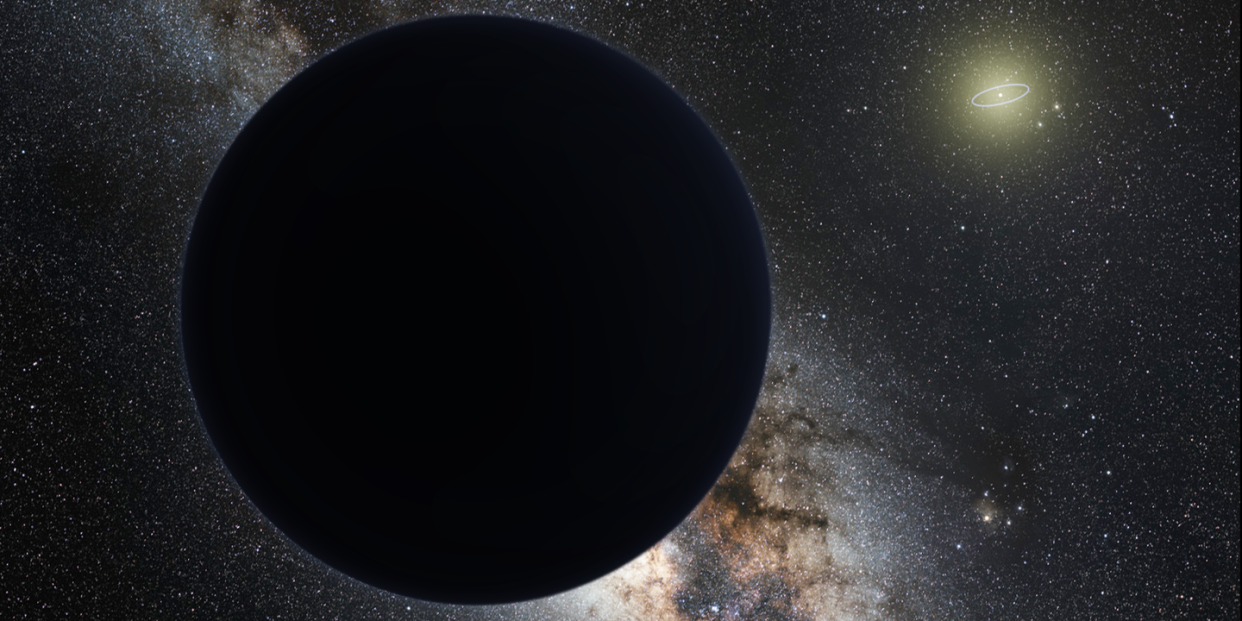Study Could Explain Away Evidence for Planet Nine

A giant gas planet orbiting in outskirts of the solar system, 20 times as far as Neptune, meandering its way around the sun every 10,000 or 20,000 years. It's a tantalizing prospect.
Planet Nine, if it exists, would be the first planet discovered orbiting the sun since Uranus in 1846 (RIP Pluto, discovered 1930). Such a discovery would rock the foundations of everything we thought we knew about our little neighborhood in space. But no one has ever observed Planet Nine directly. All the evidence for its possible existence is written in the gravitational dance of trans-Neptunian objects (TNOs)-small, cold bodies that lie far beyond the eighth planet.
However, a new model from the University of Colorado at Boulder, presented June 4 at the 232nd meeting of the American Astronomical Society in Denver, suggests a simpler explanation for these gravitational oddities: The accumulation of small encounters over many years may have knocked the objects into their strange orbits.
If it's true, then maybe there really is no ninth planet.
A Brief History of Planet Nine
The first inklings of Planet Nine began in 2014, when astronomers Chad Trujillo and Scott S. Sheppard, who specialize in minor planets, analyzed Sedna and another TNO called 2012 VP113 in a study published in Nature. These TNOs don't orbit along with the rest of the solar system, instead traveling around the sun in uniquely circular orbits. These mysterious objects never get close to giant planets such as Jupiter and Neptune, which tend to pull most of the material in the solar system into an elliptical orbit.
The Trujillo and Sheppard study suggested that "stochastic events, such as a single strong stellar encounter or rogue planet," could explain how detached TNOs ended up in their circular orbits-meaning a one-time encounter with a large object rather than a hidden planet. But astronomers began to wonder about these mysterious TNOs.
In 2016, Caltech astronomers Konstantin Batygin and Mike Brown published an analysis of additional Kuiper belt objects (KBOs) beyond Neptune in the Astrophysical Journal. These planetary bodies cluster together and fall into highly inclined orbits, meaning they orbit at an angle that's not in line with the plane of the solar system. The tilted, bunched up orbits of these objects hint at gravitational influence from Planet Nine. In addition, Barygin and Brown found the objects could be pulled away and detached from the gravitational hold of Neptune, similar to Sedna, again pointing to Planet Nine.
A New Idea
Jacob Fleisig, an undergraduate at CU Boulder and lead author of the new research, has proposed a different idea: That a series of small encounters, rather than a few big ones with Planet Nine, could explain the weirdness in the outer solar system.
"The model began by analyzing some exciting results of simulations we ran," Fleisig tells Popular Mechanics via email. "We developed a theory and tested it numerically."
The orbits of objects in the solar system are a little like the hands on a clock. Smaller objects, like the second hand, orbit faster than the bigger ones. As these small objects such as asteroids race around in their orbits, they can bunch up and accumulate on one side of the sun. These clumps of jostling small objects could have then interacted with the detached TNOs, forcing them into their strange circular orbits.
“You see a pileup of the orbits of smaller objects to one side of the sun,” Fleisig said in a press release. “These orbits crash into the bigger body, and what happens is those interactions will change its orbit from an oval shape to a more circular shape.”
Battling Hypotheses
Batygin, of Caltech, tells Popular Mechanics that any sufficiently strong gravitational encounter could detach an object from Neptune's embrace, but for the distant small bodies of the Kuiper belt to have done so through "self-gravity"-as the CU model proposes-there would need to be about five to ten times the mass of Earth in the outer parts of the Kuiper belt. There isn't.
"Unfortunately, the self-gravity story suffers from the following complications," Batygin says. "Both observational and theoretical estimates place the total mass of the Kuiper belt at a value significantly smaller than that of the Earth [only 1 to 10 percent Earth's mass]. As a consequence, Kuiper belt objects generally behave like test-particles enslaved by Neptune’s gravitational pull, rather than a self-interacting group of planetoids."
However, the researchers at CU contend that the snowballing effect they describe would be significant enough to dislodge objects from Neptune's icy grip. "There are so many of these bodies out there," CU Assistant Professor Ann-Marie Madigan said in a press release. "What does their collective gravity do? We can solve a lot of these problems by just taking into account that question.”
The new research from the CU is done through computational models that begin "after planet formation when Neptune has already scattered these bodies out of the inner solar system," Fleisig says. "The reason why this has not been explored before is because it is very computationally expensive to explore with simulations."
Planets in Hiding
In the 19th century, there was another hypothetical planet. This one, called Vulcan, was thought to orbit inside the path of Mercury.
Astronomers of the time believed this hidden planet could explain the mysterious orbit of Mercury, which just wouldn't behave like Newtonian physics said it should. When Einstein's theory of general relativity was published in the early 20th century, it provided an explanation for the orbit of Mercury, and Vulcan disappeared from the history books.
The outer solar system is much darker and more mysterious than the region around Mercury. Astronomers are just beginning to unveil the distant Kuiper belt and the shadowy realms beyond. Future work will reveal whether Planet Nine lurks in the distance, or if it's just another illusory Vulcan.
You Might Also Like

